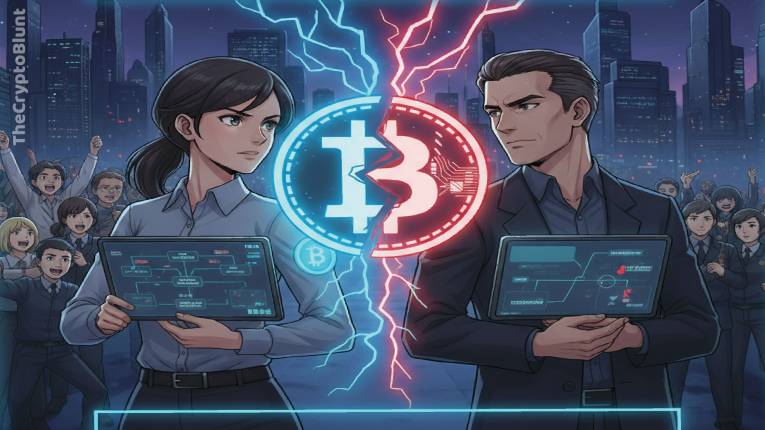Leaked messages tied to Bitcoin developer Luke Dashjr hint at a network change that could let a small committee censor some transactions.
Bitcoin’s community once again finds itself split over its core decentralization ideals, after leaked messages tied to Luke Dashjr, a Bitcoin developer, hinted at a possible network upgrade to censor illicit content from the blockchain.
On Thursday, Sept. 25, tech media The Rage reported that Dashjr may be considering a hard fork to create a “trusted” committee for Bitcoin. Citing leaked messages, it was reported by The Rage that the proposed committee would have the power to retroactively scrub illegal content from the largest blockchain—a move some say could damage Bitcoin’s core principle of censorship resistance.
The claims were rejected by Dashjr, who called the article “fake news” in an X post on September 26, shortly after the story broke. However, he hasn’t denied sending the messages that were published by The Rage. The outlet says these messages were verified by video proof.
Eyal Gruper, founder & CEO of RITREK, a platform for BTC self-custody, told The Defiant in commentary that Dashjr’s idea of a multisig committee “would break that neutrality.” He added:
“It means even a perfectly valid pre-signed transaction could be blocked because a small group of people decided they didn’t like the sender, the recipient, or the purpose. The moment people, not the protocol, decide what’s valid – Bitcoin stops being Bitcoin.”
Eneko Knörr, CEO and co-founder of the yield-bearing stablecoin project Stabolut, noted in commentary for The Defiant that the entire debate “highlights a fundamental truth about Bitcoin in my opinion: its greatest strength is that no one is in control. Its censorship resistance is paramount.”
According to Knörr, any proposal to put a committee in charge of deciding which transactions to accept or reject “would fundamentally violate Bitcoin’s core principles of freedom and neutrality.”
As the Stabolut co-founder explained, the debate was largely fueled by the surge of Ordinals and Inscriptions, which triggered discussions on Bitcoin’s primary purpose.
While this activity did lead to temporary network congestion and higher fees, the network has since adapted. With transaction fees having normalized, the argument for implementing such drastic and dangerous changes is no longer compelling, Knörr said.
OP_RETURN’s Role in On-Chain Illicit Content
The debate over how Bitcoin handles non-financial data has been simmering for years. Core developers are preparing to release v30 of the reference client in October, which changes how data is relayed by nodes via OP_RETURN, a transaction field that lets people attach small amounts of metadata such as notes or links.
Dashjr and other supporters of Bitcoin Knots, an alternative Bitcoin node client he maintains, oppose the change. They warn that it could make it easier for shady content to be spread on the blockchain.
The underlying concern is not new. Back in 2018, it was found by researchers from RWTH Aachen University that Bitcoin’s blockchain already contained non-financial content. This included an embedded image and hundreds of links to child abuse material, showing how the system’s data field can be misused.
“Bitcoin’s blockchain contains at least eight files with sexual content. While five files only show, describe, or link to mildly pornographic content, the remaining three instances are considered objectionable for almost all jurisdictions,” the researchers wrote in the report.
At the time, The Guardian reported that even a handful of such files could make possession of the blockchain legally risky in countries like Germany, the U.K., and the U.S.
Reactions to The Rage’s story from last week show just how divided the community still is. In an X post on Sept. 26, Blockstream CEO Adam Back said that Dashjr’s supposed proposal “jump[s] straight to the censorship tech” he and others had warned against.
On the other side, the report was dismissed by Udi Wertheimer, co-founder of Taproot Wizards, as a “sloppy low-quality propaganda piece.” He argued in an X post the same day that the leaked conversation was hypothetical and mischaracterized as a hardfork plan.
The Defiant reached out to Black and Dashjr for comments but did not hear back by press time.
Bitcoin Under Attack
A closer look at the screenshots from The Rage shows why both sides are making their case. The chat comes across as technical brainstorming about zero-knowledge proofs and ways for Knots nodes to skip certain transactions, which makes it seem more like a hypothetical discussion.
At the same time, the same screenshots bring up multisig sign-offs and outside legal drafting. This gives some weight to concerns about governance and censorship.
While Giacomo Zucco, an investor in OCEAN, the Bitcoin mining pool co-founded by Dashjr and financially backed by Jack Dorsey, pushed back against the article’s framing in a Friday X post, he also implied that the content of the screenshots “is nothing that Luke hasn’t said publicly hundreds of times in the past.”
In follow-up posts, Zucco explained that the “hard fork” mentioned is theoretical. It is tied to hypothetical light clients using ZK proofs, and it was implied by him that Dashjr wouldn’t consider a hard fork “until he gets consensus by everyone.”
The author of The Rage article, L0la L33tz, defended her framing in a Sept. 26 X post. She wrote that Dashjr’s messages amount to “an attack on Bitcoin” because they concede that filters alone don’t work and propose a committee empowered to retroactively alter the blockchain.
“Let me be very clear: if Luke’s hardfork is implemented, the door for law enforcement to request the removal of other data on the Blockchain is opened, making the implementation of KYC/AML technically feasible,” she added.















